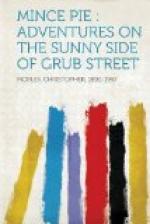Every ferry passenger is familiar with the rapid tinkling of the ratchet wheel that warps the landing stage up to the level of the boat’s deck. I asked the man who was running the wheel where I would find the Wenonah. “She lays over in the old Market Street slip,” he replied, and cheerfully showed me just where to find her. “Is she still used?” I asked. “Mostly on Saturday nights and holidays,” he said, “when there’s a big crowd going across.”
The Wenonah, as all Camden seafarers know, is a ferryboat, one of the old-timers, and I was interested in her because she and her sister, the Beverly, were Walt Whitman’s favorite ferries. He crossed back and forth on them hundreds of times and has celebrated them in several paragraphs in Specimen Days. Perhaps this is the place to quote his memorandum dated January 12, 1882, which ought to interest all lovers of the Camden ferry:
“Such a show as the Delaware presented an hour before sundown yesterday evening, all along between Philadelphia and Camden, is worth weaving into an item. It was full tide, a fair breeze from the southwest, the water of a pale tawny color, and just enough motion to make things frolicsome and lively. Add to these an approaching sunset of unusual splendor, a broad tumble of clouds, with much golden haze and profusion of beaming shaft and dazzle. In the midst of all, in the clear drab of the afternoon light, there steamed up the river the large new boat, the Wenonah, as pretty an object as you could wish to see, lightly and swiftly skimming along, all trim and white, covered with flags, transparent red and blue streaming out in the breeze. Only a new ferryboat, and yet in its fitness comparable with the prettiest product of Nature’s cunning, and rivaling it. High up in the transparent ether gracefully balanced and circled four or five great sea hawks, while here below, mid the pomp and picturesqueness of sky and river, swam this creature of artificial beauty and motion and power, in its way no less perfect.”
You will notice that Walt Whitman describes the Wenonah as being white. The Pennsylvania ferryboats, as we know them, are all the brick-red color that is familiar to the present generation. Perhaps older navigators of the Camden crossing can tell us whether the boats were all painted white in a less smoky era?
The Wenonah and the Beverly were lying in the now unused ferry slip at the foot of Market Street, alongside the great Victor Talking Machine works. Picking my way through an empty yard where some carpentering was going on, I found a deserted pier that overlooked the two old vessels and gave a fair prospect on to the river and the profile of Philadelphia. Sitting there on a pile of pebbles, I lit a pipe and watched the busy panorama of the river. I made no effort to disturb the normal and congenial lassitude that is the highest function of the human being: no Hindoo philosopher could




